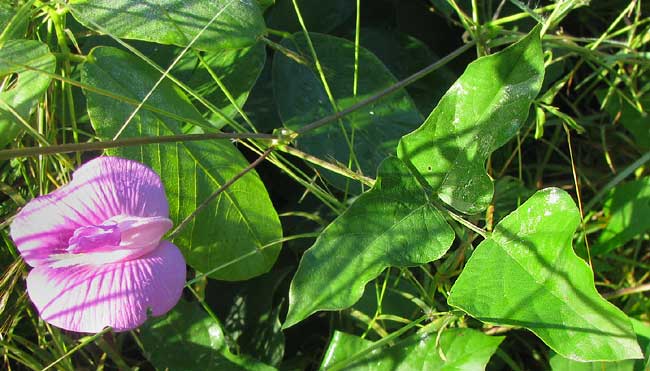Excerpts from Jim Conrad's
Naturalist Newsletter

from the January 3, 2010 Newsletter issued from Hacienda Chichen Resort beside Chichén Itzá Ruins, central Yucatán, MÉXICO; limestone bedrock, elevation ~39m (~128ft), ~N20.676°, ~W88.569°
BUTTERFLY PEA
Wildflower fanciers in the southeastern US will be familiar with the Butterfly Pea, Centrosema virginianum, a slender, vining member of the Bean Family with large, pinkish flowers. Ever since I got here, along weedy woodland trails and roadsides a different species of Butterfly Pea -- a different species of Centrosema -- has been flowering, as shown above.
That's CENTROSEMA SCHOTTII, fairly commonly distributed from southern Mexico through Central America to Ecuador and Brazil. Several Butterfly Peas occur in the Yucatan. C. schottii is distinguished from the others by its leaves' three leaflets abruptly broadening at their bases.
The blossoms of all Butterfly Pea species do something remarkable: They twist 180° on their pedicels so that the flower as we see it is upside-down relative to other Bean-Family flowers. If you need a refresher on how Bean-Family flowers have five petals consisting of the broad, top "standard", two "wings" on each side, and two lower petals fused together to form a boat- shaped "keel," I've diagrammed it all at www.backyardnature.net/fl_beans.htm.
In Butterfly Pea flowers the "standard," which usually rises above the flower, has become a broad platform spreading below the rest of the flower. You can get a better look at this peculiar configuration below:

In that picture the curving item at the top, left is the "keel," which usually lies at a bean-flower's bottom. The two side "wings" are where they should be, just oddly shaped. The blossom is over an inch long (3 cm) and will give rise to a slender, stiffly straight legume about six inches long (15 cm). In the Yucatan the flowering season lasts through most of the dry season, from October to March.